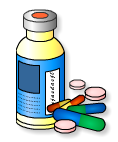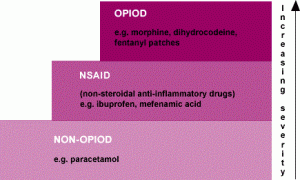
Pain is a presenting feature that may interfere with rehabilitation and cause distress to people after stroke with as many as 42% reporting some painful experience. There is still a general lack of knowledge about the way pain is perceived and reported by people with brain damage in general, and stroke in particular and it is often an overlooked symptom not well addressed in clinical care.
Analgesic intervention should match the nature and severity of the pain. There will be locally agreed protocols on the prescription of analgesia which usually follow a ‘staged’ management approach similar to that below:

Click here for the updated WHO 4 step pain ladder
To achieve the optimal analgesic affect prescribed medications should be:
- Appropriate to the pain described
- Given regularly and as prescribed. A loading dose may need to be established and maintained for the drug to be able to work effectively
- Sufficient to enable the patient to engage in physical rehabilitation
- Discussed regularly within the multidisciplinary team
NB: NSAID’s are not recommended for use in post stroke care due to a potential increased risk of bleeding if taken with antiplatelet therapy.
Patients should be made aware of the potential side effects of the medications being administered and should be closely observed for any signs of these adverse effects.
There are a number of pain assessment tools available, some of which are aphasia friendly.
Alternative methods of administration e.g. via nasogastric tube need to be considered for patients with dysphagia who cannot take medications orally.
Other interventions may include injecting the shoulder with corticosteroid or anaesthesia. In some cases hypertonus can be treated with injections of botulinum toxin but this treatment option is unusual in the early stages of stroke rehabilitation.
For more information
Feeding, nutrition and hydration following stroke: Medications
RCP Guideline for Stroke – 2016 5th Version
WHO Analgesic Ladder (updated 2020)
NICE Chronic pain in over 16s: Assessment and management (draft 2020)
Page last reviewed: 23 Mar 2021


